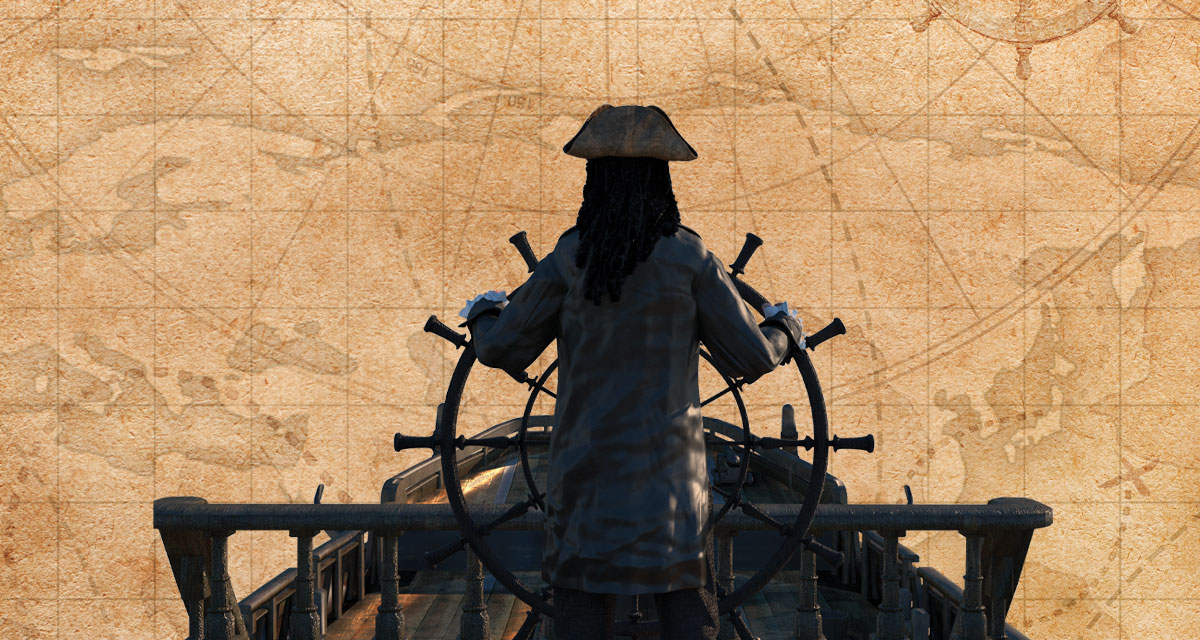Ahoy, matey! What did the ocean say to the pirate? Nothing, it just waved.
Yes, this joke may be a little corny, but I think we can all admit that talking like a pirate and making pirate jokes is fun. These rough and tough people of the seven seas experienced lives of harsh conditions, greed, and thievery. The life of a pirate is one that is known to have been short and mainly tiresome. Yet, learning about the many pirates throughout history and their daily adventures is fascinating, especially when the pirates were somewhat local.
When you think of pirates who “graced” the coast of North Carolina, Blackbeard generally comes to mind. Believed to be legally named Edward Teach, Blackbeard was an English pirate who traveled throughout the West Indies and the Eastern coast of the American colonies. He was born in the United Kingdom, but died in Ocracoke, North Carolina, in 1718. After serving as a privateer in the Royal Navy, Blackbeard turned to piracy. He would steal from merchant ships, and legend has it he would intimidate his enemies by attaching burning fuses to the end of his beard. However, Blackbeard is most famous for his blockade of Charleston Harbor in 1718. In his ship, Queen Anne’s Revenge, Blackbeard and his crew of three smaller ships ravaged five merchant ships in the harbor. As a result, traffic in the harbor stopped and a group of citizens were taken hostage by Blackbeard and his crew. The citizens were ransomed for medicine. After the looting and hostage-situation ended, Blackbeard went north. He wasn’t too faithful to his crew, as he ran three ships aground and left most of his crew. From there, Blackbeard went to North Carolina, where it is stated that he buried a treasure chest or two. Months later, in November 1718, a bounty was placed on Blackbeard by the governor of Virginia, Alexander Spotswood. The legendary pirate met his end in a naval battle off the Tarheel state’s coast and was killed by Robert Maynard, who then cut off Blackbeard’s head and hung it on his ship. Today, the skull is in storage at the Peabody-Essex Museum in Salem, Massachusetts. As for his body, it was thrown into the Pamlico Sound in the Outer Banks.
The legend of Blackbeard is much longer and more detailed than the snippet above, but he isn’t the only pirate to be familiar with our state’s coast. Here is a little bit about three, still famous, but somewhat lesser-known pirates of North Carolina.
- Jack Rackham – Known for his Jolly Roger flag with crossed swords, Jack Rackham traveled throughout the Ocracoke Inlet. Nicknamed “Calico Jack,” Rackham was ordered to flee from a French warship after leaving Blackbeard at Ocracoke by his boss, Charles Vane. After traveling to New Providence, Rackham joined forces with Anne Bonny and the life of piracy for these two began. In 1720, Rackham’s crew was overtaken in Jamaica. He was convicted of piracy and hanged in Port Royal, Jamaica on November 20.
- Stede Bonnet – With his career in piracy beginning in 1717, Stede Bonnet focused on the areas of Southport, Bath, Beaufort, and Ocracoke. A former planter, Bonnet bought a sloop, hired a crew, and sailed with Blackbeard. After losing his crew and loot to the more well-known pirate, Bonnet sailed to Bath, got a new crew and supplies, and set out to get revenge on Blackbeard. This effort ended with bad luck. Bonnet’s career ended in 1718, when he was captured by Colonel William Rhett and taken to Charleston. He was hanged on December 10, 1718.
- William Kidd – Located in Carteret County, Money Island is the supposed place where William Kidd left his buried treasure. Whether you are a treasurer hunter or not, the story of William Kidd is still captivating. Before turning to piracy, Kidd was a successful privateer and husband in New York. On January 30, 1698, Kidd captured an Armenian ship with an English captain. This action caused Kidd to become a wanted man. After leaving his crew in Madagascar, Kidd was enroute to New York, making stops along the way to bury his treasure, including a stop in North Carolina. In 1701, Kidd was arrested and convicted of piracy and murder. Like other pirates before and after him, Kidd was hanged on May 23, 1701.
North Carolina’s majestic coast is known for many things. According to some historians, our coast was an ideal stop for pirates. We were a midway point between the Caribbean and larger colonial ports in the North. In addition, our waters were often treacherous and created the perfect situation for shipwrecks, thus forming the “Graveyard of the Atlantic.” Authorities in the Outer Banks rarely did anything to stop pirates and often enforced their actions to get their own portion of the pirates’ loot.
Shiver me timbers! Who knew North Carolina was such a popular location for piracy? There are tons of resources throughout our state to learn more about these four pirates and many more who are a part of North Carolina’s coastal history. And there is no better time to say “Aye, Aye, Captain” and brush up on this portion of our state’s history than at the end of summer; otherwise, you may have to walk the plank. Ok, I’ll stop now with the pirate puns. “Blimey, heave to!”, which means to stop. Last pun, I promise.



















